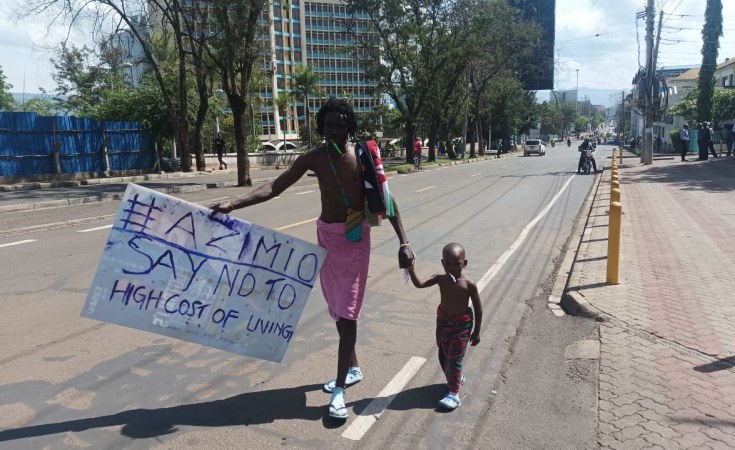- Growth in sub-Saharan Africa (SSA) is expected to slow to 3.6 percent as a "big funding squeeze", tied to the drying up of aid and access to private finance, hits the region. This is the second consecutive year of an aggregate decline in SSA growth.
- If no measures are taken, this shortage of funding may force countries to reduce fiscal resources for critical development like health, education, and infrastructure, holding the region back from developing its true potential.
- The IMF is playing its part. Between 2020 and 2022 the IMF provided more than 50 billion dollars to the region, more than twice the amount disbursed in any 10-year period since the 1990s. And as of March 2023, the IMF had lending arrangements with 21 countries, with more requests under consideration.
- Sub-Saharan Africa is far from powerless. Four policies can help navigate the current turmoil: i) consolidating public finances and strengthening public financial management, ii) containing inflation, iii) allowing exchange rates to adjust, while mitigating the adverse effects on the economy, and iv) ensuring important efforts to tackle climate change do not crowd out financing for basic needs like health and education.
Amid a global slowdown, growth in sub-Saharan Africa (SSA) is expected to decelerate to 3.6 percent before rebounding to 4.2 percent in 2024 in line with a global recovery, subsiding inflation, and a winding down in monetary policy tightening, according to the latest IMF regional economic outlook for sub-Saharan Africa published today. This will be the second consecutive year that SSA records a lower rate of growth than the previous year.
"Growth across the region varies from country to country. Some countries, particularly those in the East African Community, or non-oil resource intensive countries, are expected to fare better but some major economies bring down the average SSA growth rate, like South Africa where growth is projected to decelerate sharply to only 0.1 percent in 2023," said Abebe Aemro Selassie, Director of the IMF's African Department
Public debt and inflation are at levels not seen in decades, with double-digit inflation present in half of countries--eroding household purchasing power and striking at the most vulnerable.
The rapid tightening of global monetary policy has raised borrowing costs for SSA countries both on domestic and international markets . All sub-Saharan African frontier markets have been cut off from market access since spring 2022. The US dollar effective exchange rate reached a 20-year high last year, increasing the burden of dollar-denominated debt service payments. Interest payments as a share of revenue have doubled for the average SSA country over the past decade.
With shrinking aid budgets and reduced inflows from partners, this is leading to a big funding squeeze for the region.
"People in sub-Saharan Africa are feeling the effects of a funding crisis. Since Russia's invasion of Ukraine, cost of living is more expensive, borrowing costs have increased and access to cheaper funding is dwindling," said Mr. Selassie.
"Coupled with a long-term decline in aid and a more recent fall in investment from partners, this means that there is less money to be spent on vital services like health, education, and infrastructure. If measures are not taken, this funding squeeze will hamper Sub-Saharan's efforts to build a skilled and educated population and to be the driving force of the global economy in years to come," he added.
The IMF is playing its part and stands ready to support its members. Between 2020 and 2022 we provided more than 50 billion dollars through programs, emergency financing and Special Drawing Rights allocation. In just 2 years, the IMF provided more than twice the amount disbursed in any 10-year period since the 1990s. And as of last month, we had lending arrangements with 21 countries, with more program requests under consideration.
Sub Saharan Africa is far from powerless. To address macroeconomic imbalances, Mr. Selassie pointed to four priorities
"First, it is important to consolidate public finances and strengthen public financial management amid difficult funding conditions. This will rely on continued revenue mobilization, better management of fiscal risks, and more proactive debt management. For countries that require debt reprofiling or restructuring, a well-functioning debt-resolution framework is vital to creating fiscal space.
"Second, containing inflation. Monetary policy should be steered cautiously until inflation is firmly on a downward trajectory and projected to return to the central bank's target range.
"Third, allowing the exchange rate to adjust, while mitigating the adverse effects on the economy, including the rise in inflation and debt due to currency depreciations.
"And finally, ensuring that important efforts to tackle climate change do not crowd out basic needs, like health and education. Climate finance provided by the international community must come on top of current aid flows."
Video and audio interview with Abebe Aemro Selassie, Director of the IMF's African Department can be found here.
For more details, see the SSA Regional Economic Outlook, the Big Funding Squeeze (LINK) and accompanying analytical notes.
Geo-Economic Fragmentation: Sub-Saharan Africa Caught Between the Fault Lines demonstrates that Sub-Saharan Africa stands to lose the most in a severely fragmented world and stresses the need for building resilience.
Managing Exchange Rate Pressures in Sub-Saharan Africa: Adapting to New Realities outlines the drivers and consequences of recent exchange-rate pressures and discusses policies to help soften the impact on the region's economies.
Closing the Gap: Concessional Climate Finance and Sub-Saharan Africa considers the critical need for concessional finance in helping the region address climate change and explores ways in which additional flows might be unlocked.


